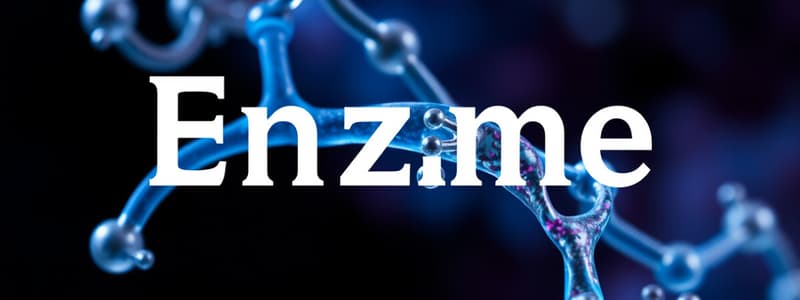Podcast
Questions and Answers
What is the substance with which an enzyme reacts?
What is the substance with which an enzyme reacts?
Substrate
Is an enzyme used up by the reaction it catalyzes?
Is an enzyme used up by the reaction it catalyzes?
False (B)
In what way does an enzyme affect the reaction it catalyzes?
In what way does an enzyme affect the reaction it catalyzes?
An enzyme increases the rate of the reaction.
What is the active site of an enzyme?
What is the active site of an enzyme?
What is meant by enzyme specificity?
What is meant by enzyme specificity?
Could life exist without enzymes?
Could life exist without enzymes?
At what temperature is enzyme activity the greatest?
At what temperature is enzyme activity the greatest?
What is the optimum pH for pepsin?
What is the optimum pH for pepsin?
How does increasing enzyme concentration affect the rate of enzyme action when substrate concentration remains constant?
How does increasing enzyme concentration affect the rate of enzyme action when substrate concentration remains constant?
How does increasing substrate concentration affect the rate of enzyme action when enzyme concentration remains constant?
How does increasing substrate concentration affect the rate of enzyme action when enzyme concentration remains constant?
How do enzymes help accelerate reactions?
How do enzymes help accelerate reactions?
What are the characteristics of enzymes?
What are the characteristics of enzymes?
What is the relationship among enzymes, energy, and reaction rates?
What is the relationship among enzymes, energy, and reaction rates?
Why do cells use different enzymes to catalyze different reactions?
Why do cells use different enzymes to catalyze different reactions?
What are enzymes?
What are enzymes?
Describe an enzyme.
Describe an enzyme.
What do enzymes permit?
What do enzymes permit?
How are enzymes needed?
How are enzymes needed?
What do enzymes enter a reaction with?
What do enzymes enter a reaction with?
Enzymes are ____.
Enzymes are ____.
Enzyme actions are ____.
Enzyme actions are ____.
Enzymes have ________.
Enzymes have ________.
Enzymes may be assisted by what?
Enzymes may be assisted by what?
How is the rate of enzyme reaction regulated?
How is the rate of enzyme reaction regulated?
What are the two theoretical models for enzyme-substrate complexes?
What are the two theoretical models for enzyme-substrate complexes?
What is the lock and key model?
What is the lock and key model?
What is the induced fit model?
What is the induced fit model?
Are all enzymes catalysts?
Are all enzymes catalysts?
What is a catalyst?
What is a catalyst?
How do enzymes lower the activation energy?
How do enzymes lower the activation energy?
Increasing the amount of substrate or enzyme will...
Increasing the amount of substrate or enzyme will...
What is the point of saturation?
What is the point of saturation?
Increasing the temperature or pH will...
Increasing the temperature or pH will...
Flashcards are hidden until you start studying
Study Notes
Enzymes Overview
- Enzymes act as biological catalysts, speeding up chemical reactions without being consumed.
- They are typically proteins with a globular structure, often having a quaternary configuration.
- Enzymes are specific to particular substrates due to the unique shape of their active sites, akin to a lock and key.
Substrate and Active Site
- Substrate: The substance on which an enzyme acts.
- Active site: The region of the enzyme where the substrate binds, allowing the enzyme-substrate complex to form.
Enzyme Function and Reaction Rates
- Enzymes increase reaction rates by lowering the activation energy required for reactions.
- At about 37 degrees Celsius, enzyme activity reaches its peak.
- Each enzyme has an optimum pH; for example, pepsin operates best at pH 4.4.
Enzyme Specificity and Models
- Enzymes exhibit specificity; they only catalyze specific reactions based on their active site shape.
- The "lock and key" model illustrates the specific fit between enzyme and substrate.
- The "induced fit" model suggests that the enzyme adjusts its shape to better fit the substrate upon binding.
Enzyme Concentration and Substrate Concentration
- Increasing enzyme concentration enhances the reaction rate to a point, after which it plateaus.
- Similarly, increasing substrate concentration raises the reaction rate until saturation is achieved, beyond which there is no significant improvement.
Regulatory Factors
- Enzyme reactions are regulated by the relative amounts of enzymes and substrates present.
- Enzymes function efficiently under mild conditions, maintaining optimum temperature and pH for activity.
Additional Characteristics
- Enzymes are used in small quantities and can be reused multiple times.
- They can be assisted by coenzymes, which are often vitamins necessary for enzyme activity.
- Enzyme actions are typically reversible, allowing for the conversion between reactants and products.
Importance of Enzymes to Life
- Without enzymes, biochemical processes would occur too slowly to sustain life.
- The absence of enzymes means that cellular reactions would fail to reach the necessary rates for metabolic function.
General Properties
- Enzymes can be classified as catalysts, but not all catalysts qualify as enzymes.
- Enzymes operate best within specific ranges of temperature and pH, where they maintain their structural integrity without denaturation.
Studying That Suits You
Use AI to generate personalized quizzes and flashcards to suit your learning preferences.




